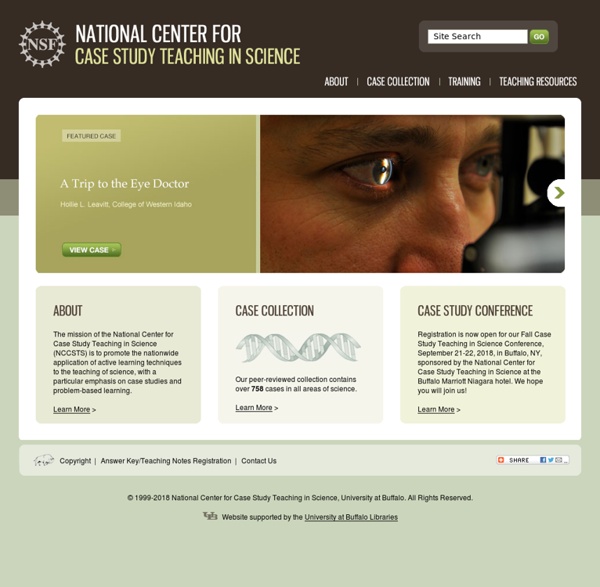



http://sciencecases.lib.buffalo.edu/cs/
from Psychology: An Introduction by Russ Dewey Hull's Theory Biological motives are those that are "wired into the nervous system." They include hunger, thirst, the pursuit of pleasure, and the avoidance of pain. Most living creatures do what they must to obtain food and water. That is why these are termed primary reinforcers. How was Hull's theory ambitious?
UMN Health Careers "Hands-on Experience" Scrubs, Gloves & Microscopes (SGM) is a “hands-on” health career exploration opportunity for high school students currently in grades 9-12. SGM gives you the opportunity to briefly experience life in a health profession. CASES Online: Creating Active Student Engagement in the Sciences What is CASES Online? CASES Online is a collection of inquiry-based lessons to engage K-12 and undergraduate students in exploring the science behind real-world problems. Through CASES, you can transform your students into motivated investigators, self-directed and life-long learners, critical thinkers and keen problem solvers. Our cases are grounded in Problem-Based Learning (PBL), Investigative Case-Based Learning (ICBL), and related student-centered pedagogies.
US NSF - Classroom Resources Classroom Resources Welcome to Classroom Resources--a diverse collection of lessons and web resources for classroom teachers, their students, and students' families. Materials are arranged by subject area to help you quickly find resources in your interest area, and then use them to create lesson plans or at-home activities. Most of these resources come from the National Science Digital Library (NSDL). NSDL is the National Science Foundation's online library of resources for science, technology, engineering, and mathematics education. It was established by the National Science Foundation to capture improvements in science, technology, engineering, and mathematics education and organize them into one point of online access.
Case It Home Page - free molecular biology computer simulations simulation software Case It! is a National Science Foundation - sponsored project which provides a framework for collaborative case-based learning via free, open-ended molecular biology simulations and cases based primarily on genetic and infectious disease . Case It v6.06 * is a simulation that performs common laboratory procedures on any DNA or protein sequence. It has all of the capabilities of the earlier version (6.05), but adds new features such as SNP and expression microarrays.
Gross Anatomy X-ray Atlas Thorax| Abdomen| Pelvis and Perineum| Upper Limb| Lower Limb| Head and Neck| PELVIS and PERINEUM HEAD and NECK Copyright © 2005, Department of Neurobiology and Developmental Sciences, University of Arkansas for Medical Sciences.
WebQuest.Org: Home Physics Games - Only Best Physics Games DivCHED CCCE: Committee on Computers in Chemical Education The Future of Case Study Teaching in Science By Clyde Freeman Herreid, University at Buffalo Paper 1: Download PDF Printable Version of Paper Abstract: Case study teaching in undergraduate science courses began 20 years ago. Today thousands of K-16 teachers are using the method and there are major websites that post hundreds of case studies and teaching notes in all STEM disciplines, especially the biological sciences. It is a puzzle why more chemists and other physical scientists have not embraced the method, since there is strong evidence that it is superior to the traditional lecture approach.
Click and Learn Click & Learn Comparing features of a 4.4-million-year-old fossil skeleton to those of human and chimpanzee skeletons sheds light on our evolutionary history. This survey, developed by Horne and Ostberg, will let you determine if you are a morning or an evening person. Teaching strategies If you have dropped into this Course Design Tutorial from somewhere else, you might wish to start at the introduction, overview, or table of contents. If you are working through the tutorial, you should have completed Part 2.1 before beginning this section. At this stage of the tutorial, you have set overarching goals, organized content, and developed a course plan with ideas for how to give students the practice that will make it possible for them to achieve the course goals.
Classroom Anatomy Online Lesson: On-line Anatomy Problem-SolvingValued Outcome: Students will have an opportunity to compose and solve problems via on-line communication. Mode of Presentation: Patient cards on-line Description of Task: Students will investigate symptoms using resource material (including the Net) and determine what human disorder or condition to describe on a "Patient Card." The card could include background information and symptoms that the patient exhibits. It may also include tests run on the patient, results obtained, and medication that was prescribed.
Genetic Witness: Science, Law, and Controversy in the Making of DNA Profiling (9780813541884): Jay D. Aronson